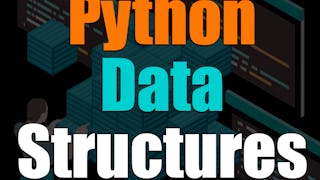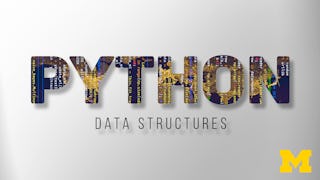This course will help you master essential data structures in Python, enabling you to write efficient code, optimize memory, and solve complex problems. By the end, you’ll be proficient in implementing arrays, linked lists, stacks, queues, trees, and graphs, along with recursion, searching, and sorting techniques.



Empfohlene Erfahrung
Was Sie lernen werden
Efficiently implement and manipulate arrays, linked lists, stacks, and queues in Python.
Develop recursive algorithms and work with binary trees and their traversals.
Analyze and solve graph-based problems using adjacency matrices and lists.
Wichtige Details

Zu Ihrem LinkedIn-Profil hinzufügen
Februar 2025
9 Aufgaben
Erfahren Sie, wie Mitarbeiter führender Unternehmen gefragte Kompetenzen erwerben.


Erwerben Sie ein Karrierezertifikat.
Fügen Sie diese Qualifikation zur Ihrem LinkedIn-Profil oder Ihrem Lebenslauf hinzu.
Teilen Sie es in den sozialen Medien und in Ihrer Leistungsbeurteilung.

In diesem Kurs gibt es 9 Module
In this module, we will explore the fundamentals of arrays, including their creation, manipulation, and applications. Starting with 1D arrays, we will cover essential operations such as searching, insertion, deletion, and updating. Then, we will progress to 2D arrays, learning how to access, insert, delete, and update elements, equipping you with the skills to handle data in Python effectively.
Das ist alles enthalten
11 Videos1 Lektüre
In this module, we will dive into Python's versatile data structures: lists, tuples, sets, and dictionaries. You will learn to perform operations like accessing, modifying, and extending lists, as well as unpacking tuples and managing dictionary key-value pairs. This section also introduces set operations, preparing you for efficient data storage and retrieval techniques.
Das ist alles enthalten
24 Videos1 Aufgabe
In this module, we will cover the essentials of recursion, starting with function basics and progressively building towards recursive solutions. You will learn how to design, implement, and debug recursive algorithms, gaining insights into their utility in solving problems like factorial computation and tree traversal.
Das ist alles enthalten
5 Videos1 Aufgabe
In this module, we will delve into linked lists, a dynamic data structure suited for efficient memory usage. You will learn to perform operations such as insertion, deletion, and searching, along with advanced techniques like identifying the middle element and comparing linked lists. This module concludes with memory management techniques like deleting a linked list.
Das ist alles enthalten
7 Videos1 Aufgabe
In this module, we will explore stacks, a fundamental data structure. You will learn various implementation methods using Python's list, collections, and queue modules. Additionally, you will apply stack operations to solve problems such as ensuring balanced parentheses, preparing you for practical programming challenges.
Das ist alles enthalten
8 Videos1 Aufgabe
In this module, we will study queues and their variants, including circular queues. You will learn how to implement queue operations using Python's built-in methods and modules. The focus will also include optimizing space and time complexities for sequential data management.
Das ist alles enthalten
6 Videos1 Aufgabe
In this module, we will explore tree structures, starting with basic terminology and progressing to binary trees. You will learn traversal techniques and implement operations to compute height and sum elements. This module lays the groundwork for understanding hierarchical data organization.
Das ist alles enthalten
9 Videos1 Aufgabe
In this module, we will focus on binary search trees, a specialized tree structure optimized for searching and data organization. You will learn how to create, search, and insert nodes into a BST, preparing you for applications that require fast and ordered data handling.
Das ist alles enthalten
4 Videos1 Aufgabe
In this module, we will introduce graphs, one of the most versatile data structures in computer science. You will learn to represent graphs using adjacency matrices and lists, equipping you with the tools to understand and implement graph-based algorithms for real-world problems.
Das ist alles enthalten
3 Videos2 Aufgaben
Dozent

von
Empfohlen, wenn Sie sich für Software Development interessieren

Coursera Project Network

University of Michigan

University of Colorado Boulder
Warum entscheiden sich Menschen für Coursera für ihre Karriere?





Neue Karrieremöglichkeiten mit Coursera Plus
Unbegrenzter Zugang zu 10,000+ Weltklasse-Kursen, praktischen Projekten und berufsqualifizierenden Zertifikatsprogrammen - alles in Ihrem Abonnement enthalten
Bringen Sie Ihre Karriere mit einem Online-Abschluss voran.
Erwerben Sie einen Abschluss von erstklassigen Universitäten – 100 % online
Schließen Sie sich mehr als 3.400 Unternehmen in aller Welt an, die sich für Coursera for Business entschieden haben.
Schulen Sie Ihre Mitarbeiter*innen, um sich in der digitalen Wirtschaft zu behaupten.
Häufig gestellte Fragen
Yes, you can preview the first video and view the syllabus before you enroll. You must purchase the course to access content not included in the preview.
If you decide to enroll in the course before the session start date, you will have access to all of the lecture videos and readings for the course. You’ll be able to submit assignments once the session starts.
Once you enroll and your session begins, you will have access to all videos and other resources, including reading items and the course discussion forum. You’ll be able to view and submit practice assessments, and complete required graded assignments to earn a grade and a Course Certificate.
Weitere Fragen
Finanzielle Unterstützung verfügbar,
 enthalten
enthalten

